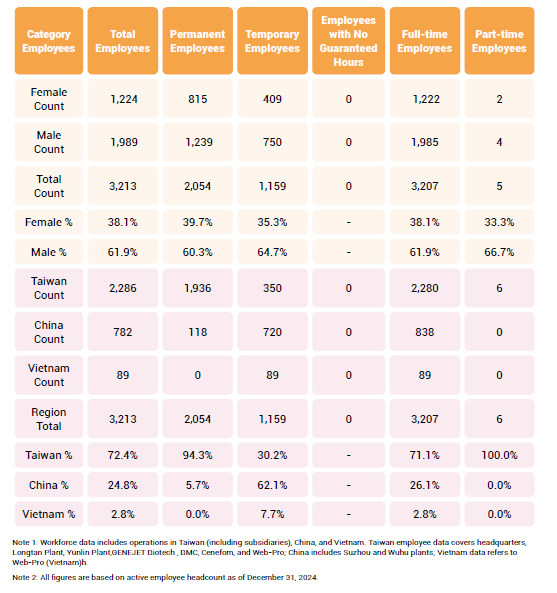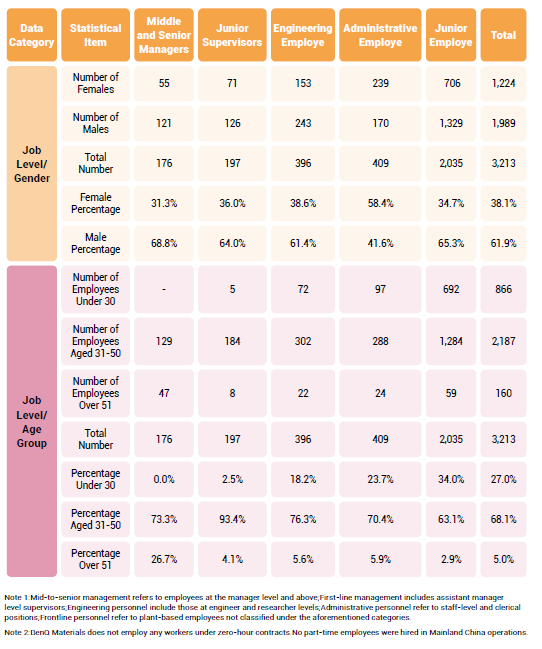Friendly Workplace
Employees are important assets to the company, and our main goal is to create a friendly workplace where employees can work with peace of mind and have opportunities for growth and development. We highly value the voices of our employees and maintain continuous communication through diverse channels. Our continuous efforts aim to create a friendly workplace with a focus on employee well-being.

Average Training Hours for Indirect Employees in 2024
The closure rate of employee complaint channels in 2024
The employee retention rate for outstanding performers in 2024 reached
Manpower Overview
Through fair, just and open recruitment mechanism, BenQ Materials aims toestablish diverse, inclusive, friendly and lively working environment. Comply withrelevant labor laws and international human rights convention of the countrywhere each business operation office is located. The company is committed tothe protection of employee human rights,and the employment policy does notinvolve any discrimination in gender, race, social and economic level, age, marriageand family status, etc. In addition, the company implements equality and fairness in the employment, recruitment criteria, remuneration, welfare, training, evaluation and promotion opportunity.The aforementioned employment policy is specified in the work rules and is also included in the employment contract and training materials for new employee orientation. BenQ Materials expects to achieve outstanding and open working atmosphere, in order to effectively increase work efficiency and team coherence.
Employee Statistics
As of December 2024, BenQ Materials employed a total of 3,213 employees globally, marking a net increase of 362 employees compared to 2023.
The major factors contributing to this growth include:
- 231 new hires at the Yunlin Plant (Yunlin, Taiwan), in response to expanded production capacity.
- 89 employees from Web-Pro Corp. (Vietnam) were included in the headcount following the company’s official consolidation.
- Taiwan: 2,286 employees
- China (Suzhou and Wuhu Plants): 838 employees
- Vietnam: 89 employees
Of the global total, 2,054 employees are permanent hires under open-ended contracts. The remaining 1,159 are temporary workers, consisting of 1,066 contract employees and 93 dispatched workers.
- Contract employees are primarily hired under open-ended terms as part of a flexible workforce strategy tailored to regional operational needs.
- Temporary workers are mostly concentrated in China and Vietnam:

As BenQ Materials’ operations are primarily based in Asia (Taiwan, Mainland China, and Vietnam), the employee population is predominantly Asian, with no representation from African, Latin American, Caucasian, or other Western ethnic groups. As of 2024, the workforce demonstrated international diversity:
- Taiwanese employees: 58.9%
- China employees: 25.9%
- Filipino employees: 8.9%
- Vietnamese employees: 5.9%
Nationality Composition of Mid-to-Senior Management
BenQ Materials actively promotes localization in management hiring. Among mid-to-senior managers in Taiwan, 99.4% are of local nationality. In Mainland China (Suzhou and Wuhu Plants), 75.0% of mid-to-senior managers are Chinese nationals.

Employee Turnover
In 2024, BenQ Materials hired 1,522 new employees, with a hiring rate of 47.4%. The average recruitment cost per hire was NTD 8,339.
In Taiwan, the overall annual hiring rate was 43.92%, with a female hiring rate of 50.12% and a male hiring rate of 40.14%, indicating a slightly higher proportion of female new hires. By age group, employees aged under 30 had an annual hiring rate of 72.69%, significantly higher than other age groups—37.32% for those aged 31–50 and 9.52% for those above 51. This reflects an expansion in operations and an increase in entry-level openings, making the younger generation the primary source of new hires.
The overall annual turnover rate in Taiwan was 34%, with a voluntary turnover rate of 33.3%. By gender, the male turnover rate was 29.6%, while the female rate was 41.3%, indicating a higher attrition rate among female employees. By age group, employees under 30 had a turnover rate of 47.2%, compared to 31.8% for those aged 31–50, and 9.5% for those over 51. When comparing turnover against the age composition of the workforce, the under-30 group accounted for the majority of employee departures. Overall, the annual turnover rate in Taiwan remained slightly below the hiring rate, reflecting a workforce structure still in a growth phase.
In mainland China (including Suzhou and Wuhu plants), the overall hiring rate was 60.0%, while the annual turnover rate reached 141.5%. This is mainly due to a tight labor supply in the local market and the use of temporary and fixed-term labor contracts to meet flexible production demands, resulting in a significantly higher turnover rate. By gender, the male hiring rate was 67.1% and the turnover rate was 154.3%, while the female hiring rate was 49.35% with a turnover rate of 122.2%.
By age, employees under 30 had a hiring rate of 93.9% and a turnover rate of 166.6%, marking them as the most mobile group. For those aged 31–50, the hiring rate was 41.9% and the turnover rate was 127.2%, while those over 51 had a hiring rate of 37.5% and a turnover rate of 187.5%.
Note 1: Annual hiring rate = (total new hires in the year / total number of employees at year-end)
Note 2: Annual turnover rate = (total departures in the year / total number of employees at year-end)
Voluntary employee turnover rate
| Year | Voluntary employee turnover rate |
| 2021 | 30.19% |
| 2022 | 30.71% |
| 2023 | 17.15% |
| 2024 | 33.3% |
Overall Turnover Analysis
According to the statistics on employee turnover reasons, approximately 56.7% of departures were due to personal factors. These include, but are not limited to, seeking other job opportunities, family caregiving responsibilities, health concerns, and personal career planning. Such data insights enable the company to better understand employee mobility trends and potential needs, serving as a critical foundation for the development of talent retention strategies and employee care initiatives.
Analysis and Management of Direct Labor Turnover
To more effectively monitor turnover trends and reasons among production line direct labor, BenQ Materials implemented a structured exit survey system in October 2024 to collect and analyze workforce data. As of the end of December, a total of 34 valid responses were received. Survey analysis revealed that the top three reasons for leaving were: difficulty adapting to the working environment (45%), receiving alternative job offers (21%), and a mismatch between job expectations and actual duties (15%).
Based on survey feedback, the company has taken immediate action to implement improvements, including enhancing pre-onboarding job briefings to ensure candidates have a clearer understanding of job content and the actual working environment. In addition, feedback related to "work environment mismatch" has been consolidated and shared with relevant departments as a reference for optimizing workplace conditions and management approaches, thereby increasing job compatibility and retention willingness among direct labor and stabilizing the workforce at the frontline level.
Regular Dialogue with Migrant Workers
BenQ Materials places strong emphasis on the well-being and workplace adaptation of migrant workers. In 2024, the company held seven dialogue sessions with foreign workers to foster mutual communication and understanding between labor and management. These meetings involved company supervisors, HR representatives, and partnering manpower agencies, providing a platform for in-depth exchanges on key concerns.
Discussions focused on improvements to dormitory conditions, work management systems and communication practices, and the alignment of job responsibilities with training arrangements. Through these regular meetings, the company has strengthened migrant workers’ understanding of and alignment with company policies, reinforced mutual trust and cooperation, and fostered a more inclusive and supportive working environment—ultimately enhancing their overall satisfaction and sense of belonging.
2024
Objective
The employee retention rate for outstanding performers
The closure rate of employee complaint channels
Percentage of female managers
The one-year postnatal retention rate
2024
Outcome
The employee retention rate for outstanding performers
The closure rate of employee complaint channels
Percentage of female managers
The one-year postnatal retention rate









